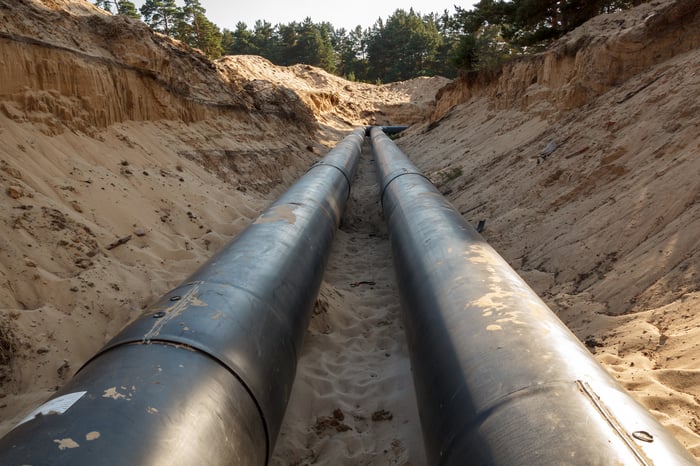Two years ago, TransCanada (TRP 0.39%) unveiled a bold five-year plan to steadily expand its energy infrastructure business so it could support 8% to 10% annual dividend growth through 2020. However, the Canadian energy infrastructure giant has outperformed those expectations and now believes dividend growth will come in at the upper end of that range. Further, the company recently extended its forecast by a year, with it now expecting to boost its payout by an additional 8% to 10% in 2021.
That's music to the ears of income-seekers because they can lock in a generous 3.7% yield today, while also enjoying meaningful income growth for at least the next four years. That said, given the company's current pipeline of projects, it should have plenty of fuel left in the tank to keep growing the payout well beyond the current horizon.

Image source: Getty Images.
The accelerator
One of the factors driving TransCanada's expectation that dividend growth will be closer to 10% annually is last year's $13 billion acquisition of Columbia Pipeline Group, which is a U.S. natural gas pipeline company. That deal did several things for the company. First, it added a stable earnings stream since fee-based contracts back the bulk of Columbia's assets. In fact, the deal bolstered the percentage of TransCanada's earnings coming from stable sources up to 92%. Meanwhile, Columbia brought $5.6 billion of commercially secured growth projects with it, which will bolster TransCanada's earnings as it builds those projects. Those factors initially led TransCanada to believe that the deal would at least support its dividend growth plan and might enable it to grow the payout at an even faster rate.
It turns out that the deal has helped push dividend growth toward the higher end of the range. TransCanada recently confirmed that it now expects earnings to grow by 10% per year through 2020, which is due in part to that deal. One of the driving forces is that the company has now secured $7.9 billion of expansions on Columbia's system through 2020, which will help provide some incremental earnings. On top of that, the company locked up an additional 2 billion Canadian dollars ($1.6 billion) of projects in its Canadian natural gas pipeline business this year. These additions pushed the company's near-term project backlog up to CA$24 billion ($18.7 billion) through 2020, which is well above the CA$13 billion ($10.2 billion) backlog it had when it started on this journey in 2015. Those projects, when combined with other business improvements, will help fuel the high-end growth through 2020, with some of that spilling into 2021 given the timing of some of its recently secured projects.

Image source: Getty Images.
But wait, there's more
In addition to those near-term projects, TransCanada currently has another CA$20 billion ($15.6 billion) of medium to longer-term projects under development. The largest is the controversial Keystone XL Pipeline, which would cost at least $8 billion to build. The company recently received regulatory approval to construct the line through Nebraska, though via a more expensive alternative route. Further, CEO Russ Girling said the company has held discussions with customers to get the commercial support needed to move forward with the project and that he was "very encouraged by the progress." If everything goes according to plan, the company could start construction next year and potentially complete it within two years, though that's assuming there are no delays, which is highly unlikely given the opposition to the pipeline.
In addition to that project, TransCanada has two other major expansions in development: CA$5.3 billion ($4.1 billion) in planned investments after 2020 to extend the life of its Bruce Power nuclear power plant and the CA$4.8 billion ($3.8 billion) Coastal GasLink Pipeline. TransCanada expects to start refurbishing the first of six reactors at Bruce Power in 2020 and work will continue through 2033, providing steady earnings growth as it makes these investments. Coastal GasLink, on the other hand, remains up in the air because the company can't move forward on that project until Royal Dutch Shell (RDS.A) (RDS.B) gives the green light on LNG Canada, which is a proposed natural gas export facility on the coast of British Columbia. Coastal GasLink would supply Shell's plant with natural gas from western Canada. According to a recent report from Reuters, Shell hopes to approve the CA$40 billion ($31.2 billion) project in 2018 if it can secure additional investment partners.
If TransCanada can obtain the approvals and contracts necessary to move forward with Keystone XL and Coastal GasLink, it would likely give the company ample fuel to continue growing its dividend by a rapid pace well past 2021.
Income stocks like this are hard to find
TransCanada has everything an investor could want in a dividend paying stock. For starters, it offers an above average yield supported by a rock-solid financial foundation since 95% of its earnings now come from stable sources, it has one of the highest credit ratings in the sector, and it pays out less than half of its cash flow. Meanwhile, it has visible growth prospects on the horizon, thanks to the expansion projects it has under construction and in development. Add it up, and the Canadian pipeline giant offers a low-risk way to collect a steadily growing income stream.





